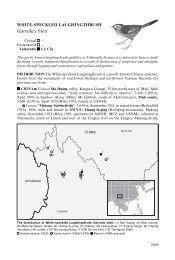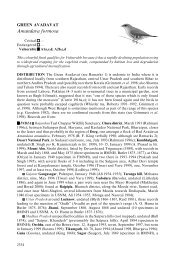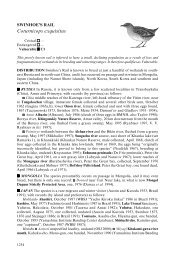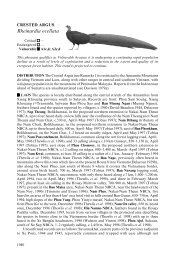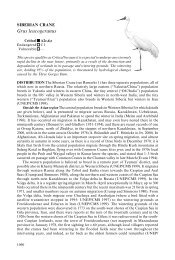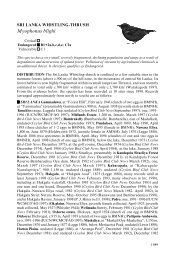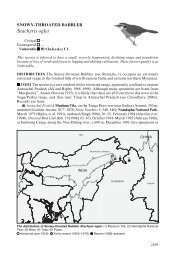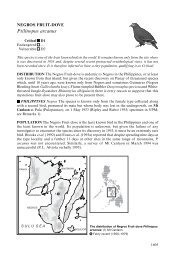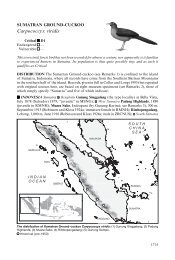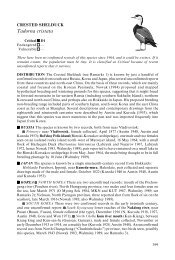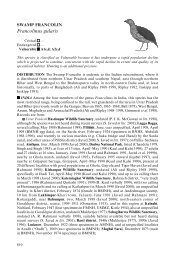Garrulax cachinnans - BirdBase
Garrulax cachinnans - BirdBase
Garrulax cachinnans - BirdBase
Create successful ePaper yourself
Turn your PDF publications into a flip-book with our unique Google optimized e-Paper software.
Threatened birds of Asia<br />
RUFOUS-BREASTED LAUGHINGTHRUSH<br />
<strong>Garrulax</strong> <strong>cachinnans</strong><br />
Critical —<br />
Endangered B1+2a,b,c,d,e<br />
Vulnerable C1<br />
This laughingthrush has a very small, declining, severely fragmented range because of loss of its<br />
forest habitat, primarily through conversion to plantations, agriculture and settlements. It<br />
therefore qualifies as Endangered.<br />
DISTRIBUTION The Rufous-breasted Laughingthrush (see Remarks 1) is one of 16 bird<br />
species endemic to the Western Ghats (Stattersfield et al. 1998) but the only one truly endemic<br />
to the Nilgiris, where its range is “curiously restricted” to montane forests (Ali and Ripley<br />
1968–1998). Reports from further afield, for example the Western Ghats of Karnataka (see,<br />
e.g., Uttangi 1994b), are in error. Confirmed records are from:<br />
■ INDIA ■ Kerala Wynaad district, a rare resident, 1985–1988 (Zacharias and Gaston 1993);<br />
Silent Valley National Park, uncommon, 1973–1997 (Zacharias and Gaston 1999), in the<br />
upper regions, 1994 (Vijayan et al. 1999); Thodukky range, Palghat district, 1994–1997<br />
(Vijayan et al. 1999); Munnar, one, January 1996 (P. Holt in litt. 1999); unspecified location<br />
in “Malabar”, pre-1888 (specimen in BMNH), and “hills east of Cannanore” (Kannur),<br />
undated (specimen in BMNH);<br />
INDIA<br />
B A Y<br />
O F<br />
B E N G A L<br />
KARNATAKA<br />
5 9<br />
1 6<br />
7<br />
8<br />
13<br />
11<br />
2 12<br />
10<br />
3 14 TAMIL NADU<br />
4<br />
KERALA<br />
SRI LANKA<br />
The distribution of Rufous-breasted Laughingthrush <strong>Garrulax</strong> <strong>cachinnans</strong>: (1) Wynaad district; (2) Silent<br />
Valley National Park; (3) Palghat district; (4) Munnar; (5) Naduvattam; (6) Kalhatti; (7) Kotagiri; (8) Doddabetta;<br />
(9) Udagamandalam; (10) Mukurti National Park; (11) Wellington; (12) Coonoor; (13) Avalanche; (14) upper<br />
Bhavani.<br />
Historical (pre-1950) Recent (1980–present) Undated<br />
2072
<strong>Garrulax</strong> <strong>cachinnans</strong><br />
■ Tamil Nadu Naduvattam (Neddivittum), 1977 (specimens in BNHS), two, 1986 (Harrap<br />
1986b), November 1994 (Gee 1995), 2–4 on each of six visits, January 1994–January 1998 (P.<br />
Holt in litt. 1999); Kalhatti (Kallatti) February and March 1947 (two specimens in USNM),<br />
undated (specimen in USNM); Kotagiri, c.1,200 m, undated (Davison 1883, Hume and Oates<br />
1889–1890), 1923–1925 (specimen in YPM, Whistler ms), 1965, 1977 (specimens in BNHS<br />
and BMNH), and specifically at Longwood shola and Kil Kotagiri, 1997 (A. Bhupathy in<br />
litt. 1997, Gokula and Vijayan 1999); Doddabetta, March 1947 (four specimens in USNM,<br />
YPM); Udagamandalam (Ootacamund, Ooty), 1,800–2,500 m, fairly common in forests and<br />
botanic gardens, etc., recorded from the early nineteenth century down to the present (Jerdon<br />
1839–1840, Betham 1902, Koelz 1947, Khan 1977, 1979, Islam 1987, 1990), and still common<br />
in 1990s, e.g. July 1995 (S. H. M. Butchart in litt. 2000), 1–8 on nine dates, January 1994–<br />
December 1997 (P. Holt in litt. 1999), also nearby at Cairnhill Reserve Forest, in a degraded<br />
shola, 1984 (Robson 1984), four, December 1997 (P. Holt in litt. 1999); Mukurti National<br />
Park, c.1982 (Islam 1985), 1988–1990 (Robertson and Jackson 1992), 1994 (Vijayan et al.<br />
1999), October 1997 (L. Vijayan in litt. 1999); Wellington, 1901 (specimen in BMNH); Coonoor,<br />
undated (at “Chinnaconoor”) (Morgan 1874), 1873 (specimen in AMNH), 1882 (specimen<br />
in BMNH), “very common”, May 1904 (Dewar 1905), not found in 1982 (Islam1985) but<br />
four, January 1996 (P. Holt in litt. 1999); Avalanche, 1943, 1971 (two specimens in BNHS);<br />
upper Bhavani, 1977 (specimen in BNHS), 1994–1997 (Vijayan et al. 1999).<br />
In addition, a few untraced localities fall within a small area in Nilgiri district of Tamil<br />
Nadu. These include Bison swamp, 1994–1997 (Vijayan et al. 1999); Governor’s shola, c.1982<br />
(Islam 1985); Kurtukuli, c.1982 (Islam 1985); and Thalakundah, c.1982 (Islam 1985). In all<br />
probability, the few other untraced localities—Kilmelford, 1935, 1938 (three specimens in<br />
YPM), Parson’s valley, c.1982 (Islam 1985), Portimund, c.1982 (Islam 1985)—are also in<br />
this district.<br />
POPULATION In the nineteenth century, Davison (1883) judged the Rufous-breasted<br />
Laughingthrush to be “exceedingly numerous” on the plateau and upper slopes of the Nilgiris,<br />
being “one of the most characteristic birds” of these hills, occurring “wherever there are a<br />
few bushes or a little scrub”. In early twentieth-century accounts it continued to be called<br />
“extremely common” (Baker 1922–1930) or “exceedingly common” (Whistler and Kinnear<br />
1931–1937) wherever sufficient cover remained; around 1900 it was “very common” around<br />
Coonoor (Dewar 1905), and very common at Udagamandalam, although noted as possibly<br />
declining (Betham 1903).<br />
Although it remains locally abundant, the species occupies a highly restricted range where<br />
suitable habitat is diminishing rapidly, and thus its overall numbers might well now be low<br />
and declining. Its population centre is the Nilgiris of Tamil Nadu; it is generally a rare and<br />
local bird in Kerala. In this latter state it is “uncommon” at Silent Valley National Park<br />
(Gaston and Zacharias 1996, Vijayan and Gokula 1999, Zacharias and Gaston 1999), rare in<br />
Wynaad (Zacharias and Gaston 1993, 1999) and absent almost everywhere else. In Tamil<br />
Nadu, however, it is common in the high ground of the Nilgiris. During a study in these hills<br />
between 1994 and 1997 population density in undisturbed shola forests was calculated to lie<br />
at 160–210 individuals per km 2 , while in disturbed shola forests it was 90–130 per km 2 , while<br />
in completely altered habitat (wattle or Acacia plantation) numbers were much lower, with<br />
only 20–40 per km 2 (Vijayan and Gokula 1999, Vijayan et al. 1999). According to Khan<br />
(1979) it is absent from Acacia plantations, uncommon (seen on 25–50% of visits) in Eucalyptus<br />
plantations, and irregular (seen on fewer than 25% of visits) in tea plantations. In 1994–1996<br />
seven pairs bred in a disturbed forest of about 4 ha while only one pair bred in a 20 ha wattle<br />
plantation near a stream with rhododendron bushes (Vijayan and Gokula 1999). Population<br />
densities are clearly much higher in natural vegetation types, despite Davison’s (1883) claim<br />
to have found them in any patch of bush or scrub.<br />
2073
Threatened birds of Asia<br />
ECOLOGY Habitat The species is very similar in its habits and ecological requirements to<br />
its geographically isolated congener the Grey-breasted Laughingthrush <strong>Garrulax</strong> jerdoni (Ali<br />
and Ripley 1968–1998, Islam 1985). It inhabits dense evergreen forest, wooded gardens and<br />
thick scrub (Davison 1883, Betham 1902, Baker 1922–1930), especially shola (ravine or upland<br />
depression) forests with dense undergrowth and shrubs at the edges, at all elevations above<br />
1,200 m but especially above 1,900 m (Baker 1922–1930, Whistler and Kinnear 1931–1937,<br />
Khan 1977, 1978, Islam 1985). It is uncommon in eucalypt, rare in tea and absent in acacia<br />
plantations (Khan 1977, 1978, Vijayan and Gokula 1999). The highest populations occupy<br />
undisturbed natural forests, with lower densities in disturbed natural forests and low<br />
population densities in exotic plantations (Vijayan and Gokula 1999, Vijayan et al. 1999).<br />
The species is evidently group-territorial, each group “consisting of a dozen or more birds”<br />
including a monogamous pair; both sexes defend the territory (Islam 1994; also Baker 1922–<br />
1930). Birds roost mainly on peripheral branches of trees or shrubs (Islam 1985).<br />
Food The species prefers to forage at the forest edge and feeds on invertebrates, nectar,<br />
flowers and fruits, mostly within 3 m of the ground, and mostly in the early morning and late<br />
afternoon (Islam 1987). Baker (1922–1930) reported T. C. Jerdon finding that it feeds<br />
principally on the imported Peruvian cherry Physalis peruviana as well as invertebrates; Ali<br />
and Ripley (1968–1998) reported the use of berries of wild raspberry Rubus and hill guava<br />
Rhodomyrtus tomentosa.<br />
Breeding Breeding occurs between February and the end of June (Hume and Oates 1889–<br />
1890, Baker 1922–1930), with January to July as extremes (Islam 1994); the peak laying<br />
period has variously been identified as May–June (Ali and Ripley 1968–1998), April to early<br />
May (Betham 1902), or January–April (Islam 1994). In 1995–1996 most egg-laying in Upper<br />
Bhavani was recorded in March–April (Vijayan et al. 1999). The nest, a rather bulky but<br />
compact affair with a very deep cup, is constructed of roots, dead leaves, small twigs, grass,<br />
lichen and moss, lined with fine fibres, rootlets, withered bark, cotton wool, fur or feathers<br />
(Hume and Oates 1889–1890, Baker 1922–1930, Bates 1931, Islam 1994). It is placed in the<br />
upright fork of branches in bushes or small trees in forest at a height of 1–4 m (Hume and<br />
Oates 1889–1890, Baker 1922–1930, Islam 1994). Although the species is “fond of thick<br />
jungle”, it usually nests “on the outskirts or in small trees more or less in the open” (Betham<br />
1902). Both sexes apparently take part in all nesting activities (Islam 1994). The clutch generally<br />
comprises two eggs (Islam 1994), sometimes three, apparently never more (Baker 1922–1930),<br />
although 3–5 eggs have been reported at Coonoor (Hume and Oates 1889–1890). The average<br />
incubation and nestling periods were 16 days each, and nesting success was reported to be<br />
60% by Islam (1994).<br />
THREATS The Rufous-breasted Laughingthrush is one of (now) four threatened members<br />
of the suite of 16 bird species that are entirely restricted to the “Western Ghats Endemic Bird<br />
Area”, threats and conservation measures in which are profiled by Stattersfield et al. (1998).<br />
Large-scale conversion of habitats into plantations, reservoirs, crops and human habitations<br />
poses the major threat to this species (Gaston 1985a, Gaston and Zacharias 1996, Vijayan et<br />
al. 1999, Vijayan and Gokula 1999). Plantations of tea, Eucalyptus, and Acacia have been<br />
expanding, and represent the major threat to shola forests and grasslands in the higheraltitude<br />
regions of the Western Ghats (Pramod et al. 1997, Vijayan et al. 1999). The earlier<br />
practice of retaining streams and bordering patches of sholas while converting the forests<br />
and grasslands into plantations has been abandoned, to the detriment of habitat quality and<br />
biodiversity (Khan 1979).<br />
MEASURES TAKEN Silent Valley National Park in Kerala and Mukurti National Park in<br />
Tamil Nadu are the only two protected areas within the range of the species. There are some<br />
sholas partly protected as reserve forests in the upper Nilgiris included in the Nilgiri Biosphere<br />
2074
<strong>Garrulax</strong> <strong>cachinnans</strong><br />
Reserve, which however does not in practice provide any habitat protection (L. Vijayan in<br />
litt. 1999). There have been some moves to stop further conversion of forests and grasslands<br />
into plantations in Tamil Nadu (K. S. Neelakantan verbally 1997).<br />
MEASURES PROPOSED Alteration of forests and grasslands remaining in the Nilgiris<br />
have to be stopped. Restoration of these natural habitats can be done in the Upper Nilgiris<br />
with peoples’ participation (Vijayan et al. 1999, Vijayan and Gokula 1999). In the existing<br />
old plantations, measures should be taken to save the undergrowth and shrubs, and all<br />
perennial sources of water and vegetation on their banks (Khan 1979). Extension of Mukurti<br />
National Park to cover some important forest habitat has been suggested, and steps are<br />
being taken according to the park warden (A. Udayan verbally 1999). Regular monitoring<br />
of shola forest populations is also suggested (Vijayan et al. 1999).<br />
REMARKS (1) This use of the scientific name is sensu stricto, with the exclusion of certain<br />
taxa (G. jerdoni, G. f. fairbanki and G. f. meridionalis) regarded by Peters 1931–1987 as<br />
conspecific.<br />
2075



